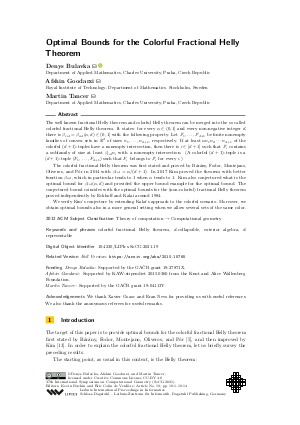Optimal Bounds for the Colorful Fractional Helly Theorem
Authors
Denys Bulavka  ,
Afshin Goodarzi,
Martin Tancer
,
Afshin Goodarzi,
Martin Tancer
-
Part of:
Volume:
37th International Symposium on Computational Geometry (SoCG 2021)
Part of: Series: Leibniz International Proceedings in Informatics (LIPIcs)
Part of: Conference: Symposium on Computational Geometry (SoCG) - License:
 Creative Commons Attribution 4.0 International license
Creative Commons Attribution 4.0 International license
- Publication Date: 2021-06-02
File

PDF
LIPIcs.SoCG.2021.19.pdf
- Filesize: 0.8 MB
- 14 pages
Document Identifiers
Related Versions
- Full Version https://arxiv.org/abs/2010.15765
Subject Classification
ACM Subject Classification
- Theory of computation → Computational geometry
Keywords
- colorful fractional Helly theorem
- d-collapsible
- exterior algebra
- d-representable
Metrics
- Access Statistics
-
Total Accesses (updated on a weekly basis)
0PDF Downloads0Metadata Views
Abstract
The well known fractional Helly theorem and colorful Helly theorem can be merged into the so called colorful fractional Helly theorem. It states: for every α ∈ (0, 1] and every non-negative integer d, there is β_{col} = β_{col}(α, d) ∈ (0, 1] with the following property. Let ℱ₁, … , ℱ_{d+1} be finite nonempty families of convex sets in ℝ^d of sizes n₁, … , n_{d+1}, respectively. If at least α n₁ n₂ ⋯ n_{d+1} of the colorful (d+1)-tuples have a nonempty intersection, then there is i ∈ [d+1] such that ℱ_i contains a subfamily of size at least β_{col} n_i with a nonempty intersection. (A colorful (d+1)-tuple is a (d+1)-tuple (F₁, … , F_{d+1}) such that F_i belongs to ℱ_i for every i.)
The colorful fractional Helly theorem was first stated and proved by Bárány, Fodor, Montejano, Oliveros, and Pór in 2014 with β_{col} = α/(d+1). In 2017 Kim proved the theorem with better function β_{col}, which in particular tends to 1 when α tends to 1. Kim also conjectured what is the optimal bound for β_{col}(α, d) and provided the upper bound example for the optimal bound. The conjectured bound coincides with the optimal bounds for the (non-colorful) fractional Helly theorem proved independently by Eckhoff and Kalai around 1984.
We verify Kim’s conjecture by extending Kalai’s approach to the colorful scenario. Moreover, we obtain optimal bounds also in a more general setting when we allow several sets of the same color.
Cite As Get BibTex
Denys Bulavka, Afshin Goodarzi, and Martin Tancer. Optimal Bounds for the Colorful Fractional Helly Theorem. In 37th International Symposium on Computational Geometry (SoCG 2021). Leibniz International Proceedings in Informatics (LIPIcs), Volume 189, pp. 19:1-19:14, Schloss Dagstuhl – Leibniz-Zentrum für Informatik (2021)
https://doi.org/10.4230/LIPIcs.SoCG.2021.19
BibTex
@InProceedings{bulavka_et_al:LIPIcs.SoCG.2021.19,
author = {Bulavka, Denys and Goodarzi, Afshin and Tancer, Martin},
title = {{Optimal Bounds for the Colorful Fractional Helly Theorem}},
booktitle = {37th International Symposium on Computational Geometry (SoCG 2021)},
pages = {19:1--19:14},
series = {Leibniz International Proceedings in Informatics (LIPIcs)},
ISBN = {978-3-95977-184-9},
ISSN = {1868-8969},
year = {2021},
volume = {189},
editor = {Buchin, Kevin and Colin de Verdi\`{e}re, \'{E}ric},
publisher = {Schloss Dagstuhl -- Leibniz-Zentrum f{\"u}r Informatik},
address = {Dagstuhl, Germany},
URL = {https://drops.dagstuhl.de/entities/document/10.4230/LIPIcs.SoCG.2021.19},
URN = {urn:nbn:de:0030-drops-138186},
doi = {10.4230/LIPIcs.SoCG.2021.19},
annote = {Keywords: colorful fractional Helly theorem, d-collapsible, exterior algebra, d-representable}
}
Author Details
Funding
- Bulavka, Denys: Supported by the GAČR grant 19-27871X.
- Goodarzi, Afshin: Supported by KAW-stipendiet 2015.0360 from the Knut and Alice Wallenberg Foundation.
- Tancer, Martin: Supported by the GAČR grant 19-04113Y.
Acknowledgements
We thank Xavier Goaoc and Eran Nevo for providing us with useful references. We also thank the anonymous referees for useful remarks.
References
-
R. Aharoni, R. Holzman, and Z. Jiang. Rainbow fractional matchings. Combinatorica, 39(6):1191-1202, 2019.

-
N. Alon and G. Kalai. A simple proof of the upper bound theorem. European J. Combin., 6(3):211-214, 1985.

-
N. Alon, G. Kalai, J. Matoušek, and R. Meshulam. Transversal numbers for hypergraphs arising in geometry. Adv. in Appl. Math., 29(1):79-101, 2002.

-
I. Bárány. A generalization of Carathéodory’s theorem. Discrete Math., 40(2-3):141-152, 1982.

-
I. Bárány, F. Fodor, L. Montejano, D. Oliveros, and A. Pór. Colourful and fractional (p,q)-theorems. Discrete Comput. Geom., 51(3):628-642, 2014.

- D. Bulavka, A. Goodarzi, and M. Tancer. Optimal bounds for the colorful fractional Helly theorem. Preprint, 2020. URL: http://arxiv.org/abs/2010.15765.
-
J. Eckhoff. An upper-bound theorem for families of convex sets. Geom. Dedicata, 19(2):217-227, 1985.

-
E. Helly. Über Mengen konvexer Körper mit gemeinschaftlichen Punkten. Jahresber. Deustch. Math.-Verein., 32:175-176, 1923.

-
E. Helly. Über Systeme von abgeschlossenen Mengen mit gemeinschaftlichen Punkten. Monaths. Math. und Physik, 37:281-302, 1930.

-
G. Kalai. Intersection patterns of convex sets. Israel J. Math., 48(2-3):161-174, 1984.

-
G. Kalai and R. Meshulam. A topological colorful Helly theorem. Adv. Math., 191(2):305-311, 2005.

-
M. Katchalski and A. Liu. A problem of geometry in Rⁿ. Proc. Amer. Math. Soc., 75(2):284-288, 1979.

-
M. Kim. A note on the colorful fractional Helly theorem. Discrete Math., 340(1):3167-3170, 2017.

-
L. Lovász. Problem 206. Matematikai Lapok, 25:181, 1974.

-
E. Nevo. Algebraic shifting and basic constructions on simplicial complexes. J. Algebraic Combin., 22(4):411-433, 2005.

-
M. Tancer. Intersection patterns of convex sets via simplicial complexes: A survey. In J. Pach, editor, Thirty Essays on Geometric Graph Theory, pages 521-540. Springer New York, 2013.

-
G. Wegner. d-collapsing and nerves of families of convex sets. Arch. Math. (Basel), 26:317-321, 1975.

